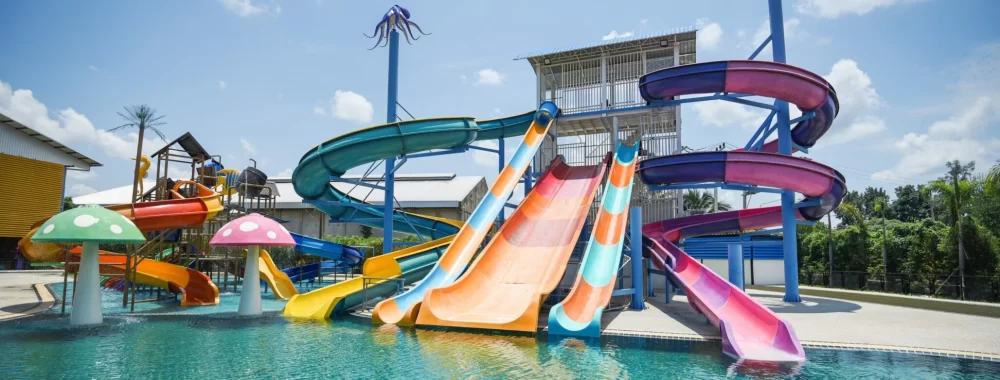
Understanding the Importance of Water Park Safety
Water parks are exciting, thrilling places for families and friends to enjoy their time together. The rush of sliding down a water slide, floating lazily along a lazy river, or diving into wave pools can be exhilarating. However, as much as we love these water adventures, it's important to remember that water parks, like any other recreational space, come with their own set of risks. Knowing how to handle emergencies and issues in these environments can make all the difference in ensuring everyone has a fun and safe time.
In this article, I’ll walk you through common water park emergencies, practical safety tips, and real-life examples that show how quick thinking and preparation can prevent accidents. Let’s dive into how you can stay prepared and keep yourself and your loved ones safe.

Rolling Hills Water Park
7660 Stony Creek Rd, Ypsilanti Township, MI 48197, USA
1. Handling Water Park Emergencies: What You Need to Know
The first step in managing any water park emergency is understanding what could go wrong. Some of the most common incidents include slips, falls, dehydration, heat strokes, drowning, and injuries from rides. While water parks have trained lifeguards on site, it's important to be proactive in handling minor emergencies until professional help arrives.

Grayslake Spray Park
250 Library Ln, Grayslake, IL 60030, USA
Common Emergencies You Might Encounter
Accidents happen unexpectedly, and they can range from minor to serious. Here are some examples of common emergencies:
- Drowning: This is the most serious emergency situation. It can happen in seconds and often without much noise. Drowning is silent and quick, so always keep an eye on swimmers, especially children.
- Injuries from Slides or Rides: Sometimes, people can get hurt while on rides or slides. Whether it's a twisted ankle or a more serious injury, it’s essential to report the injury immediately and ensure the victim is cared for until help arrives.
- Heat Stroke and Dehydration: Spending long hours in the sun can lead to heat-related issues. Make sure to hydrate and seek shade if you start feeling dizzy or nauseous. Always look for signs of heat stroke in others, including confusion, rapid breathing, and fainting.
- Slips and Falls: Wet surfaces increase the risk of slipping and falling. Although water parks regularly clean and maintain their walkways, it’s essential to walk cautiously and wear appropriate footwear when possible.
What to Do in Case of Emergency
If you find yourself in the middle of an emergency at a water park, it's important to stay calm and take immediate action. For instance, if someone is drowning or struggling in the water, immediately signal for help, and if you're trained, attempt to rescue them carefully without putting yourself at risk. In case of injury or heat stroke, seek assistance from staff or lifeguards without delay.
2. Preventing Emergencies: Tips for Staying Safe
While emergencies can happen unexpectedly, taking precautions can significantly reduce the risks. Here are some essential tips to follow to stay safe:
Know the Safety Rules
Before you even step into a water park, familiarize yourself with the safety guidelines posted around the park. These rules are not just recommendations; they are designed to prevent accidents and ensure the safety of all visitors. Adhere to the height and weight limits for rides, understand the park's emergency procedures, and always follow the lifeguard's instructions.
Stay Hydrated and Take Breaks
Water parks can be physically demanding, and with the sun beating down, it’s easy to become dehydrated. Keep a bottle of water with you, especially on hot days. Take regular breaks to rest and cool off in the shade to avoid heat exhaustion.
Watch Out for Children
If you're visiting a water park with children, it’s vital to keep a close eye on them at all times. Water slides, pools, and wave areas can be overwhelming, so make sure your kids know how to swim and follow safety instructions. If they can’t swim, consider using life jackets or floatation devices.
3. Real-Life Examples of Water Park Emergencies and How They Were Handled
One of the best ways to learn about handling emergencies is by looking at real-life examples. Let me share a few stories from my experience to illustrate the importance of quick thinking in water parks.
The Rescue of a Drowning Child
It was a busy summer afternoon at one of the most popular water parks in the area. I was relaxing by the wave pool when I noticed a child struggling in the water. A mother was frantically calling out for help, but no one seemed to notice at first. I immediately ran over to the lifeguard station and alerted the staff. In the meantime, I kept an eye on the child, who was too young to swim by herself. The lifeguard quickly jumped in and rescued the child, and after a quick check, the child was fine. The incident was a reminder of how crucial it is to remain vigilant and act swiftly in such situations.
Injury from a Water Slide
One summer day, I witnessed an accident where a guest was injured while coming down a water slide. The person seemed to have lost control at the bottom of the slide and twisted their ankle. The water park staff reacted quickly, providing first aid and calling for medical assistance. The guest was soon on their way to get further medical treatment. This incident underscored the importance of ensuring that water slides are used according to safety guidelines.
4. How to Report and Address Issues at the Water Park
Sometimes, things don’t go as smoothly as we would like. Whether it’s a faulty ride, inadequate safety measures, or another issue, it’s essential to know how to report these problems to ensure the safety of future guests.
Reporting Safety Concerns
If you notice something unsafe at a water park, whether it’s a ride that seems broken or a slippery surface, it’s important to report it to the nearest staff member. They can take the necessary action to prevent accidents from occurring. Some parks even provide a safety hotline or mobile app for quick reporting.
How Parks Address Issues
Once an issue is reported, water parks have a procedure in place to address the concern. Staff will assess the situation, close the ride if necessary, and fix the issue. In the case of emergencies, water parks have clear protocols to provide immediate medical attention, evacuate visitors if necessary, and conduct thorough investigations to prevent future incidents.
By staying informed and knowing how to respond to emergencies, you can contribute to a safer, more enjoyable experience at any water park. Stay safe, stay aware, and always be prepared to handle any issue that may arise during your visit.










